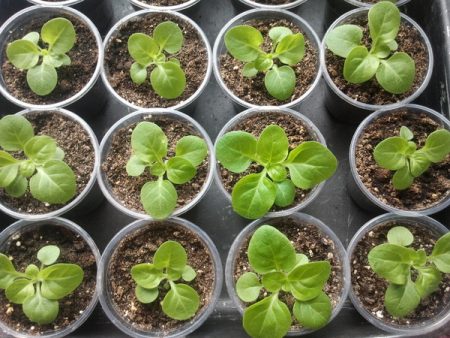
Many summer residents use annual flowers to decorate their front gardens. They are unpretentious, easily propagate, bloom profusely and continuously, have bright and varied colors. Petunia is one of the most unpretentious flyers. They love this flower for the variety of colors that miniature bushes bloom from June to the very frosts.
Gardeners willingly propagate petunias, even in spite of the difficulty of growing seedlings of this flower. Each grower has his own tricks of cultivating petunias, which help them achieve excellent results. It is important in this matter to comply with some recommendations for breeding a pet, and then the petunia will give its owner unusually beautiful flowers of all shades of the rainbow.
Petunias are propagated by seeds, sown directly in open ground (soil crops) or seedlings, which are grown in rooms on windows and in boxes or pots.
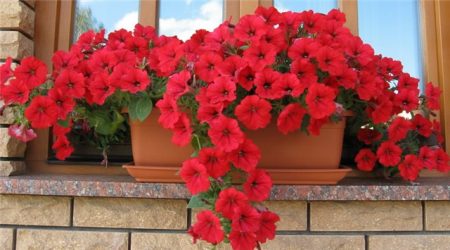
Content
- 1 Variety selection and seed preparation for sowing
- 2 Dates of planting petunia seeds
- 3 Selection and preparation of soil for sowing
- 4 Selection of capacity for seedlings of petunia
- 5 The technique of sowing petunia seeds for seedlings
- 6 Pick
- 7 Sowing in peat tablets
- 8 Growing seedlings in the "snail"
- 9 Petunia Seedling Care Tricks
- 10 Why do petunia seedlings fall and die
Variety selection and seed preparation for sowing
For lovers of petunias, who have repeatedly dealt with this flower, the selection of varieties for seedlings does not seem difficult. But what about beginners who have their eyes scattered in the store from countless bright packages with flower seeds?
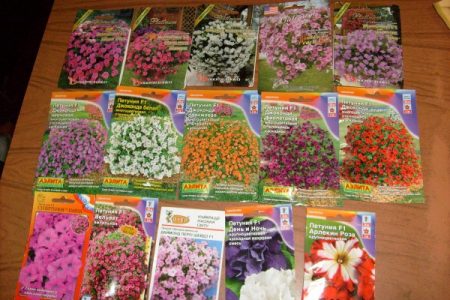
Many make the mistake of choosing flowers "in the picture." Yes, you can, of course, buy those flowers that are best depicted on the packaging, but then the result can be unpredictable, which will possibly erase the whole future associated with such a beautiful flower as petunia. In choosing a variety, it is best to rely on objective criteria:
- place of cultivation. Shrub varieties are suitable for a flower garden (open ground), ampel or cascade varieties are suitable for balcony cultivation;
- external effect. If you need a flower hat from small flowers along the bottom row of the flower garden, then you should choose petunias - multiflora; and when you want to make something bright and unusual from the front garden, large-flowered terry varieties or super-bissims are suitable;
- specific color. Many summer residents skillfully compose the colors and shades of their flower garden. Therefore, the variety can be selected based on the color of the overall color composition.
In addition, you can choose a variety characterized by persistent immunity, resistance to adverse weather conditions, flowering periods, etc.
You also need to pay attention to what type of petunia you get: a hybrid or a variety. After all, it is known that the collected seeds of hybrid varieties are not used for sowing seedlings, since they do not have the same qualities as the mother ones. Seeds of the usual variety can be collected on their own and sown in the new season.
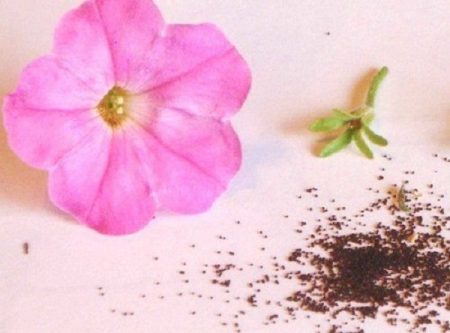
The shelf life of the seeds is of no small importance: the seeds of petunias hatch for a very long time, if they still turn out to be old, then the seedlings may not appear at all. And the wait time will be wasted.
The bulk of the seeds today are sold in pelleted or granular form. These seeds have a larger size, and therefore it is more convenient to sow them (for example, in a peat tablet). In addition, the seeds have already been treated with special drugs that are responsible for the immune system and friendly, early seedlings. There are usually few seeds in the package, and they cost several times more than ordinary petunia seeds.
Cheaper bags pack more seeds. All of them are very small, so they are planted mainly in bulk, since it is almost impossible to pry them with tweezers. Such seeds need pre-planting preparation, since their germination rate is usually not very high.
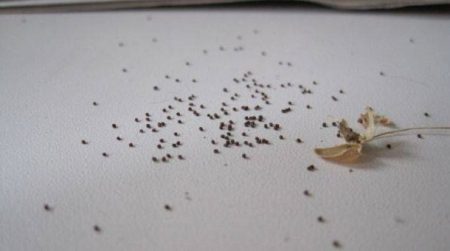
Stages of seed treatment:
- etching. Reception is carried out in order to prevent diseases. It can be done by soaking in hot water (50 degrees) for 30 minutes or soaking in a solution of manganese;
- soaking. To accelerate the process of germination, the seeds are kept in warm water (25-30 degrees) in a saucer, covered with gauze. As soon as the seeds absorb moisture, the water is again slightly added. There should not be too much water. As soon as the seeds hatch, they are dried and sown;
- treatment with a solution of trace elements. This speeds up seed germination, seedling growth and increases disease resistance.
Dates of planting petunia seeds
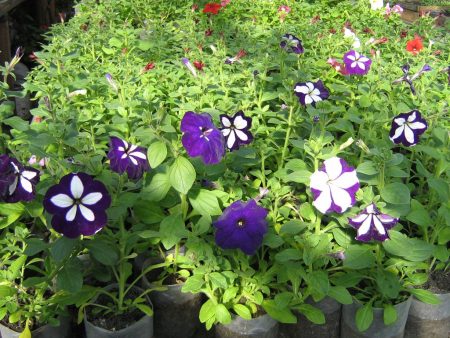
To pick a variety and buy seeds is half the battle. The next important point is to determine the timing of sowing. Many beginner gardeners think that seeds can be sown at any moment, forgetting that in each period of growth of petunia seedlings, individual conditions are necessary that cannot always be provided based on the characteristics of the season of the year. Yes, for example, you can sow petunias back in January. But then you need to understand that, since petunia is demanding on light, seedlings need to be artificially highlighted. If this is not possible, then it is more rational to postpone the sowing until March.
In addition, petunia is a heat-loving plant, therefore, it is planted in open ground only from mid-June, not earlier. If you consider that in order to grow strong healthy seedlings of petunia you need 12-13 weeks, then sowing seeds for seedlings in the middle of the first month of spring is the best option.
When to plant seeds for seedlings according to the lunar calendar

Seasoned gardeners perform all agricultural work according to the lunar calendar. On such a horoscope, you can calculate favorable days for sowing petunias.
In 2018, these days include:
- February 6–8, 21, 22, and 25;
- March 13–15, March 20–22;
- April 17–20, 25 and 26.
Selection and preparation of soil for sowing
All plants require optimally comfortable conditions for germination, namely light, loose, nutritious and moisture- and breathable soil. Flowers in this regard are especially demanding, since their root system is much less developed than the rhizomes of vegetable crops, which means that any "complication" of the soil will affect their development to a greater extent.
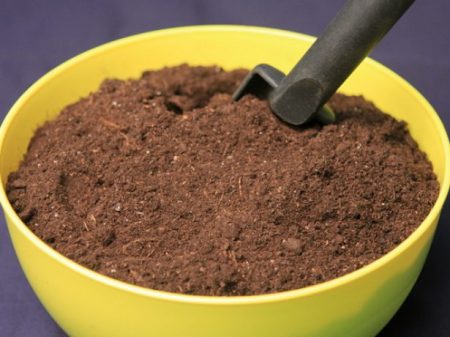
The soil for petunia seedlings can be bought or mixed independently. By the way, self-made soil will give you a guarantee that there are no pests or pathogens in it.
So, the soil substrate is prepared from several components: sand, peat, loamy soil. All composite soil mixtures should be taken in equal quantities:
- Peat - an indispensable component of any seedling soil, since it is sterile. You can use both lowland (black) peat, which is famous for the fact that it is more nutritious and low acid, and high (red) - thanks to its loose structure and moisture resistance, it is the best suited for growing petunia seedlings.
- Present in soil sand gives it friability and porosity. By the way, only river sand of white or gray color is suitable.
- The composition should also contain turfas it contains nutrients. And if there are not enough organic elements in it, then biohumus or compost is added to the mixture.
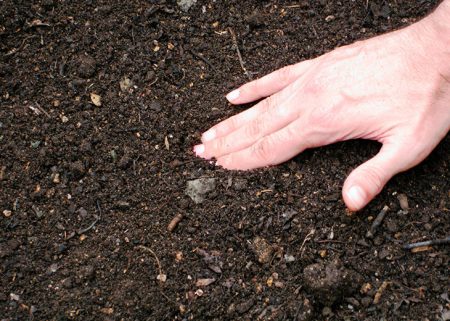
It does not matter whether the soil is prepared on its own or bought in a store, it must first be disinfected. You can do this in two ways: calcine in the oven at temperatures above 100 degrees or spill with hot water in which potassium permanganate is diluted. Only after these manipulations is the earth packaged in seedlings and sown.
Selection of capacity for seedlings of petunia
Pilot seeds are sown for seedlings in pots, boxes, paper or plastic cups, peat tablets.
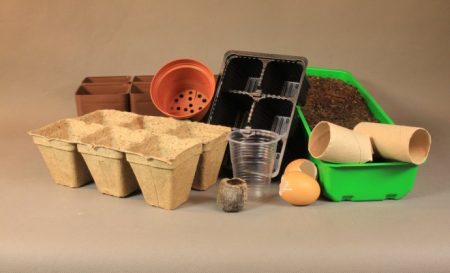
When choosing containers for germinating petunias, it should be borne in mind that the material of which the seedlings are made must not conduct heat well. So, metal containers are not suitable. Wood, plastic and ceramic products are quite suitable. It is also necessary that the container has a hole for the outflow of excess moisture. For crops, you can also use cookie boxes, food containers, preferably with lids, to create a greenhouse effect.
In general, the choice of containers is not a matter of principle. The main thing is that the container is convenient to use, and subsequently it was easy to take out seedlings from it when diving.
The technique of sowing petunia seeds for seedlings
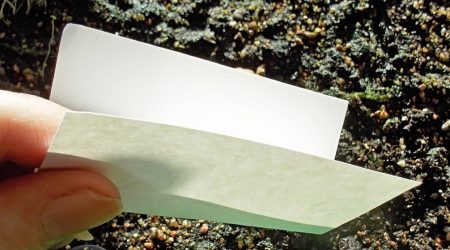
When the main preparatory work has been carried out - a container for seedlings has been selected, a mixture has been prepared and the most favorable day has been picked up - you can start sowing.
Sowing loose petunia seeds is not for the faint of heart. Often the size of flower seeds is not more than half a centimeter, and therefore it is very difficult to lay them out with a certain step on the ground. Of course, it is better to use granular or pelleted seeds. They are more dimensional, and therefore pry them with tweezers and spread on the ground is quite simple. Moreover, you can sow granules piece by piece immediately in pots or peat tablets, slightly deepening in moistened soil.
Equal sowing will provide better germination and uniform growth of seedlings. The disadvantage of granular seeds is their high cost. In one bag, there can be from three to seven seeds, while in an ordinary bundle of them there is a whole scattering. And, if spending money is not a problem, we recommend that you do not waste your nerves and time on cheaper options.
With loose seeds, everything is somewhat more complicated. Since it is not possible to sow them individually, it is possible to resort to various methods of planting such a miniature sowing material to ensure the best seedlings.
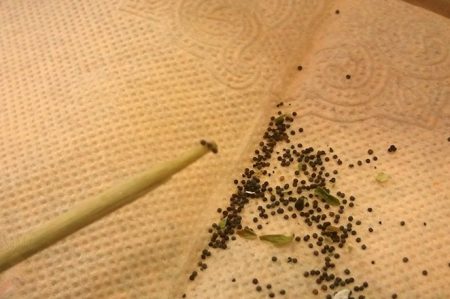
Ways to plant petunia seeds:
- Mix with sand. Drainage is poured at the bottom of the seedling tank, and 6-10 centimeters thick is laid on top. The soil is well moistened. In a separate container, a small amount of sand is mixed with seeds. Then the mixture is laid out in a thin layer on the surface of wet soil. Then the crops are sprayed with warm water from the spray gun.
- Sowing in the snow. Snow is laid out on a soil surface in a thin layer. Then they sow the seeds directly in the snow. The bottom line is that if the seeds in some place are heaped, then you can easily redistribute them, since in the snow it is not difficult to do. With melting, the snow “absorbs” the seeds into the ground to the required depth. Watering such crops, of course, is not necessary.
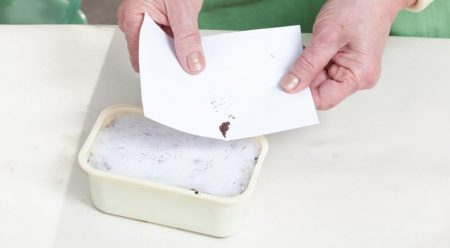
- Sowing with a tool.For especially patient summer residents, the option may be suitable when the seeds are laid out piece by piece on the surface of the soil with a toothpick or tweezers. To make the seed easier to pick up, the end of the toothpick should be moistened with water. And to shake off the seed will help another, but already dry toothpick. Then the crops should be carefully watered.
It doesn’t matter what seeds were used for sowing, but containers with future seedlings must be covered with film or glass and left in a room where the temperature is + 20-22 degrees. It is important to keep the soil slightly moist, and the accumulating condensate must be cleaned regularly. If everything is done correctly, the first shoots will appear in a week.
Pick
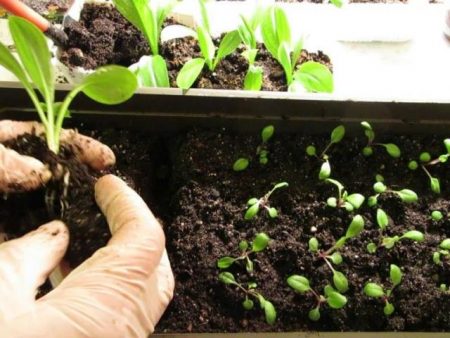
So that the seedlings do not squeeze each other and do not stretch, they are dived, that is, they are planted in rows at a greater distance, shortening the main root by one third.
A pick is prescribed at a time when 2-3 real leaflets appear on the seedlings of petunias (not to be confused with cotyledons). Presumably this will happen 3-4 weeks after sowing.
Large containers are selected for picking, with holes in the bottom for draining excess water. Light and nutritious soil is poured into seedlings, which are well moistened with warm water before the transplant procedure.
The dive is carried out with the help of a dive peg, with which a bush of petunias is tucked and carefully transferred together with part of the earth on the root to a new place. The sprout is deepened down to the cotyledon leaves (they should remain on the surface).
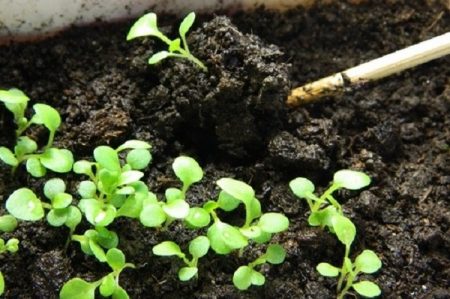
Specialists recommend diving seedlings of petunia in 11-cm clay pots of three each, in paper cups - one each, in seedling boxes - 50 each.
The sprouted seedlings are required to be watered and shaded for the first time. When the seedlings get stronger, they are exposed to the southern windows so that the flowers receive as much sunlight as possible.
Before planting in the soil, seedlings begin to harden. Young shoots are placed in cooler conditions when the daytime temperature is 18 degrees and the nighttime temperature is 15. Daily seedlings are taken out to the veranda or porch. And the room is regularly ventilated.
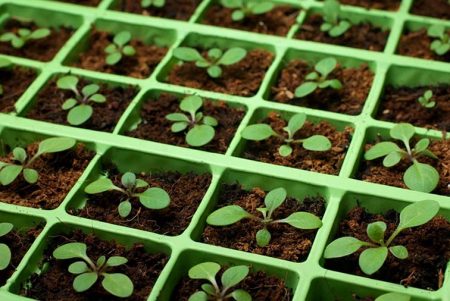
Sowing in peat tablets
To facilitate the task of growing seedlings of various vegetable and flower crops, special natural containers were invented - peat tablets. They are made from peat - an environmentally friendly material that has good air and water permeability, friability, and therefore is ideal for growing petunias. Peat containers are produced in the form of compressed tablets, which increase in size as moisture enters. Moreover, various mineral elements are already included in their composition, and therefore seedlings living in such tablets rarely need additional top dressing.
Before sowing, the tablets are placed in a large box or other container in which they can stand. Then they are abundantly watered so that the tablets swell and take the required size. In the upper part of the tablet, a depression is made and a petunia seed is placed there, and again watered from a pipette or spray bottle.
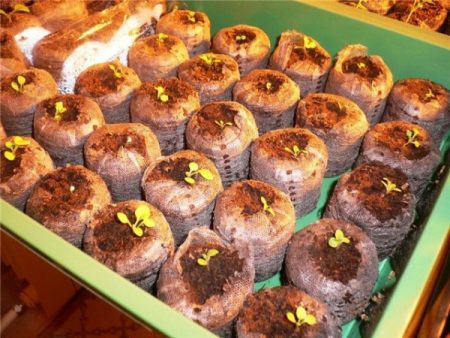
Granular seeds are usually sown in tablets. But simple seeds are also suitable, it just takes more time and patience. If seeded seeds are sown, then getting into peat, they slightly soak. They need to be kneaded a little and smeared on peat.
The advantage of growing seedlings in peat tablets is that the dive procedure is excluded here. The fact is that over time, seedlings will also need to be transplanted into a more spacious container or planted in open ground. However, it will be much easier to do this, since the transplant will need to be done directly in this tablet, that is, without removing the seedling from peat. This greatly facilitates and speeds up the process of caring for seedlings of petunias.
The box in which peat tablets rest in orderly rows should also be covered with a lid to create a moist, warm environment. The tablets are poured “over the bottom”, that is, pouring water into the common container in which the tablets are located.
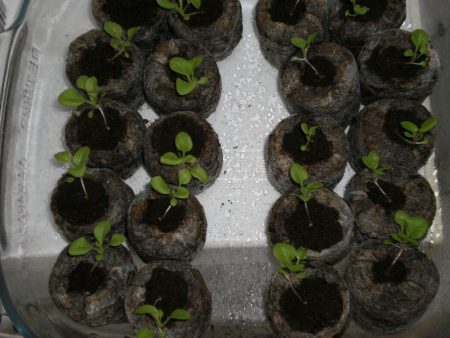
Peat seedling care is standard. After emergence, the film or glass is removed, and the temperature in the room is slightly reduced (from 23 degrees to 19). After a couple of weeks, it is again raised to its previous values.
It is important to control the level of humidity, avoiding stagnation of water and drying out of the earth. Landings are periodically aired. And when the time comes to transplant seedlings to a permanent place, it will be very simple to do. You can be calm, because the seedlings will not experience unnecessary stress associated with the transplant, which means that the plants will immediately continue to grow and bloom earlier.
Growing seedlings in the "snail"
When you need to save space in the apartment, but still want to grow flowers, the “snail” method is used to germinate petunia seedlings. However, looking ahead, we immediately make a reservation that this is not the best way to grow flower seedlings. But first things first…
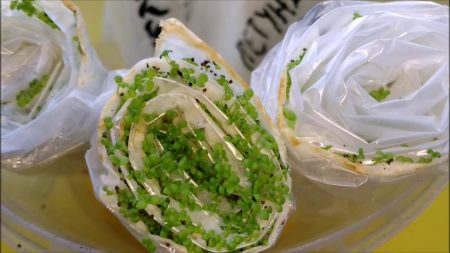
A “snail” is a rolled-up tape made of polyethylene, toilet paper or a laminate substrate in which seeds are placed. This method provides faster and better seed germination.
A snail is used when there is practically no land in the arsenal. With this method of germination, seedlings cannot be brought to the very landing in the ground, but to the stage of picking - completely.
So, the essence of seed germination in the "snail":
- a tape measuring 15 * 100 centimeters is cut out of polyethylene;
- a layer of toilet paper is rolled over the tape;
- moisturize the paper;
- from one edge of the strip on the surface of wet paper lay out seeds at a distance of 4 centimeters from each other;
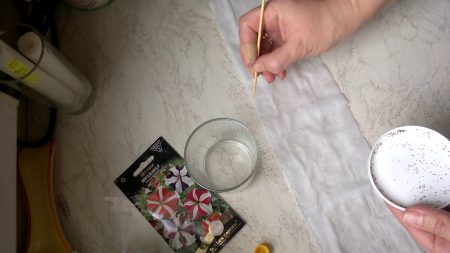
- on top of the seeds put another layer of paper, moisten it with water;
- all layers are covered with another polyethylene tape;
- neatly roll the structure into a roll;
- the resulting "snail" is tied with a rope so that the structure does not fall apart;
- the snail is placed in a high capacity with seeds up;
- water is poured into the bottom of the can with a layer of up to 5 centimeters. On top of the container with a snail is covered with a bag to create a greenhouse effect;
- the result is a compact twisted roll with a diameter of 10-12 centimeters, which takes up a minimum of space in the room.
To provide seedlings with nutrients during the "planting" work, a little soil is sprinkled on top of the toilet paper. After all, plants still need soil.
One of the advantages of this method of seed germination is the fact that the plants do not touch each other with their roots.It is very convenient to extract shoots during a dive - it is enough to roll the tape and remove sprouts from it.
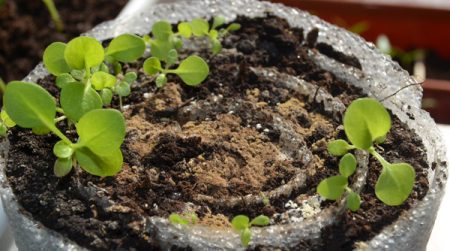
The lack of sprouting in litte is obvious - because of the dense planting, plants receive very little sunlight. Their roots can be sandwiched between layers, and therefore develop poorly. Seedlings grow weaker than during normal germination.
Petunia Seedling Care Tricks
Petunia is a delicate flower and picky about temperature, humidity and the degree of illumination. Initially, only two components are needed for seed germination - heat and humidity. But gradually, with fasting, the shoots need more and more light. Petunia seeds are sown mainly at the end of winter, when there is very little sunlight outside the window. Naturally, for healthy growth, seedlings of light need much more. Therefore, seedlings should be additionally illuminated using phytolamps. Tanks with petunia seedlings begin to intensively lighten up from about 2-3 weeks, when newborn juicy shoots cover the entire surface of the earth with a green carpet. It is then that in parallel you need to reduce the air temperature in the room to 16-18 degrees of heat.
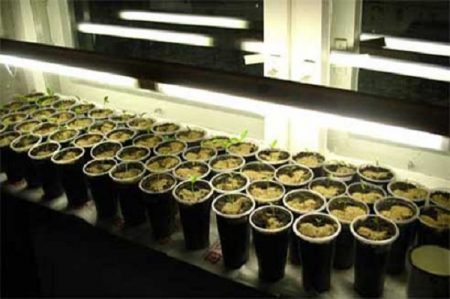
It is necessary to water the seedlings of petunia often, but not abundantly, but slightly adding water to keep the soil moist in the floor. The first two weeks the seedlings should be in a state of greenhouse effect. To do this, the seedlings are kept under the film, but to control the humidity level inside the seedling tank, preventing condensation from getting on the leaves. Watering is carried out from the spray gun, after which airing is carried out for 15-20 minutes. The grown petunias are watered from a syringe or pipette and only under the root. The film or glass is removed only when the first pair of leaves appears on the shoots.
In general, competent watering of petunias is the key to the successful cultivation of healthy seedlings. This flower has a low resistance to various fungal diseases. The black leg is especially dangerous for petunias. Therefore, it is important to ensure that moisture does not accumulate on the surface of the soil. In order to prevent the development of this disease, you need to sprinkle dry clean sand.
Top dressing
In the seedling period, petunia consumes a lot of nutrients, therefore, for full development, it must be constantly nourished with elements containing a large amount of nitrogen.
Weak seedlings can be sprayed with a growth stimulant (for example, Epin, Bud). You can also fertilize seedlings with mineral fertilizers.
A week after the dive, plants are fed nitrogen-phosphorus fertilizers. You can use ready-made mixtures (Crystal), as well as add superphosphate.
To form a strong stocky bush will help form calcium nitrate.
The best nutrition for seedlings of petunia is considered to be wood ash, as it contains more than 30 nutrients, so necessary for flowers. The more nitrogen and other elements seedlings will receive, the better will be its growth and flowering. Also, ash can enhance plant immunity.
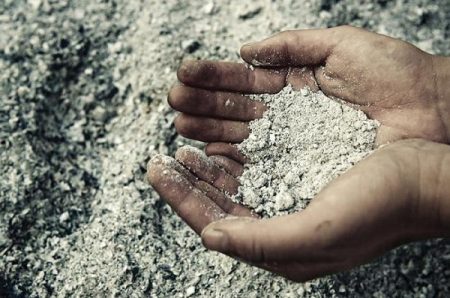
Top dressing from ash is prepared with water, and bushes under the root are watered with this solution. After a week, the recharge is repeated. Dry ash can also be applied by simply showering the ground under the bushes with a nutrient substrate.
Feeding should be done at intervals of 12-14 days. In a week you can see from seedlings how she reacts to one or another type of recharge. Do not get too carried away with fertilizers. The onset of the next feeding should be determined solely by the appearance of the plants.
Why do petunia seedlings fall and die
Flowers are very delicate creatures. And it’s not easy to grow them. At every step, seedlings are in wait for trouble, which can affect the health of young shoots.
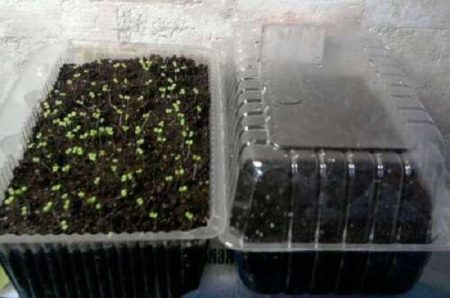
Reasons why seedlings fall and die:
- The first difficulties appear with seedlings. Or rather, with the fact that there are no seedlings at all or they are very bad. This may occur due to the strong penetration of seeds into the soil during sowing. It is known that the seeds of petunias are very small, and therefore very weak. They simply cannot get through the soil layer. Therefore, the seeds of petunias are not covered with earth, but simply laid out on the surface of the soil and lightly watered so that they "drown" to the required depth.
- Poor seed quality. This is one of the reasons for "not sprouting" seeds, in which the gardener is not guilty. Seeds may be old or rotten, and therefore they do not have viability.
- Shoots do not peel off the shell and die. It so happens that the shoots are too weak and can not independently throw off the shell, which subsequently becomes the cause of the death of seedlings. Perhaps this is due to the fact that the seeds are bad or in the box under the film is too dry. If it became obvious that seedlings have such a problem, then you need to increase the humidity of the environment. The frequency of airing is reduced. You can even help the shoots to throw off the shell: for this, the shoots need to be moistened with water, pry off the film with a needle and remove it yourself.
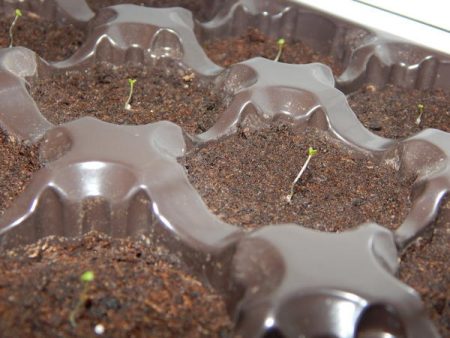
- The defeat of the disease. It so happens that suddenly seedlings begin to fall and die quickly. The reason for this may be a disease called the "black leg". If the stem at the base has darkened, this means that the plants were hit by a fungus from the ground. There is a disease with excessive soil moisture and the absence of airing. In such a very humid and warm environment, the fungus develops rapidly. And if you ignore the onset of the disease, then after a few days the disease will spread to all landings. Unfortunately, sick plants cannot be saved - they will have to be thrown away as soon as possible. Healthy seedlings need to be peaked in new soil. A weak hilling of the earth under the shoot can save from the fungus, watering in such a way that the earth near the stem remains dry.
Adult seedlings are affected by a black leg due to weakened immunity. To increase the vitality of petunias, they are treated every ten days with a nitrofoam, Kemira or Mortar.
- Sometimes seedlings fall, as it grows in adverse conditions. Or rather, too few sun rays fall on it, and the temperature in the room is too high. As a result, the stems stretch excessively, while they are very frail, and therefore begin to fall to the sides. If you do not take measures, then the seedlings will not give the necessary number of branches for lush flowering. Therefore, if there is not enough light, then you need to illuminate the petunias with artificial light.
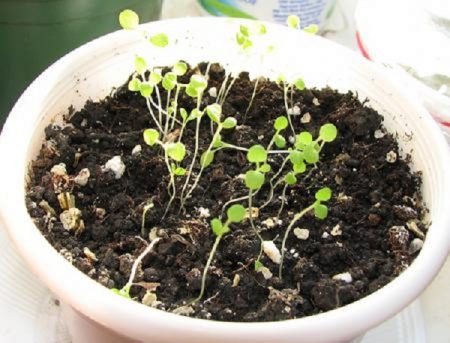
It is also possible that the seedlings grow too densely and those plants that are in the thickets do not receive a large amount of light. In this case, the flowers should be thinned out.
Drawing seedlings is also possible due to dry air in the room. This often happens in the winter, when the heating is on. To avoid overgrowing seedlings, boxes with petunias are lowered to the floor or lower the temperature in the room.
Pinch will help slow down the rapid growth of stems up. Then the growth of the lateral branches is activated.
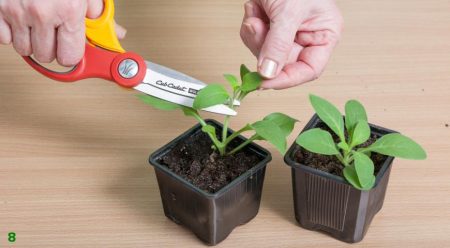
- Lack of mineral elements. By the appearance of petunia plants, you can understand what nutrients they lack. The foliage color speaks about the lack of this or that vitamin:
- if there is little nitrogen, the leaves are small and yellow;
- with a lack of phosphorus - the color of the leaves becomes blue-violet;
- if the lower leaves turn yellow, there is too much nitrogen;
- if the upper leaves turn yellow and white, the plant lacks iron.
All this can be avoided if complex mineral supplements are applied on time.And if harmful insects attacked the seedlings, then it is possible to get rid of them only by treating the bushes with insecticidal agents.
- Seedlings stop growth. Often you can observe a situation when the seedlings suddenly stop growing, and then die. This is due to the small amount of soil in the seedling tank. The roots simply have nowhere to develop, and plant growth stops accordingly. Solving the problem is quite simple - you need to transplant seedlings into a more capacious container.
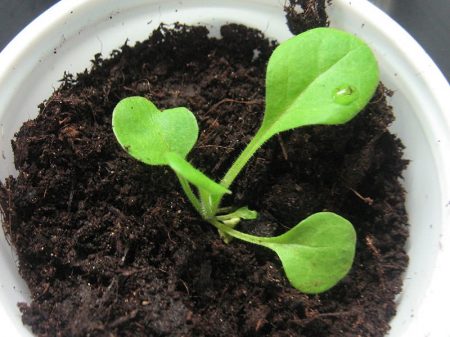
Growing healthy seedlings of petunias is not an easy task. The reasons why you can ruin the young flowers mass. But all of them mainly come from the gardener's ignorance of the rules of agricultural technology. You can correct all errors only by observing all the recommendations, and enveloping the flowers with your attention and daily care.

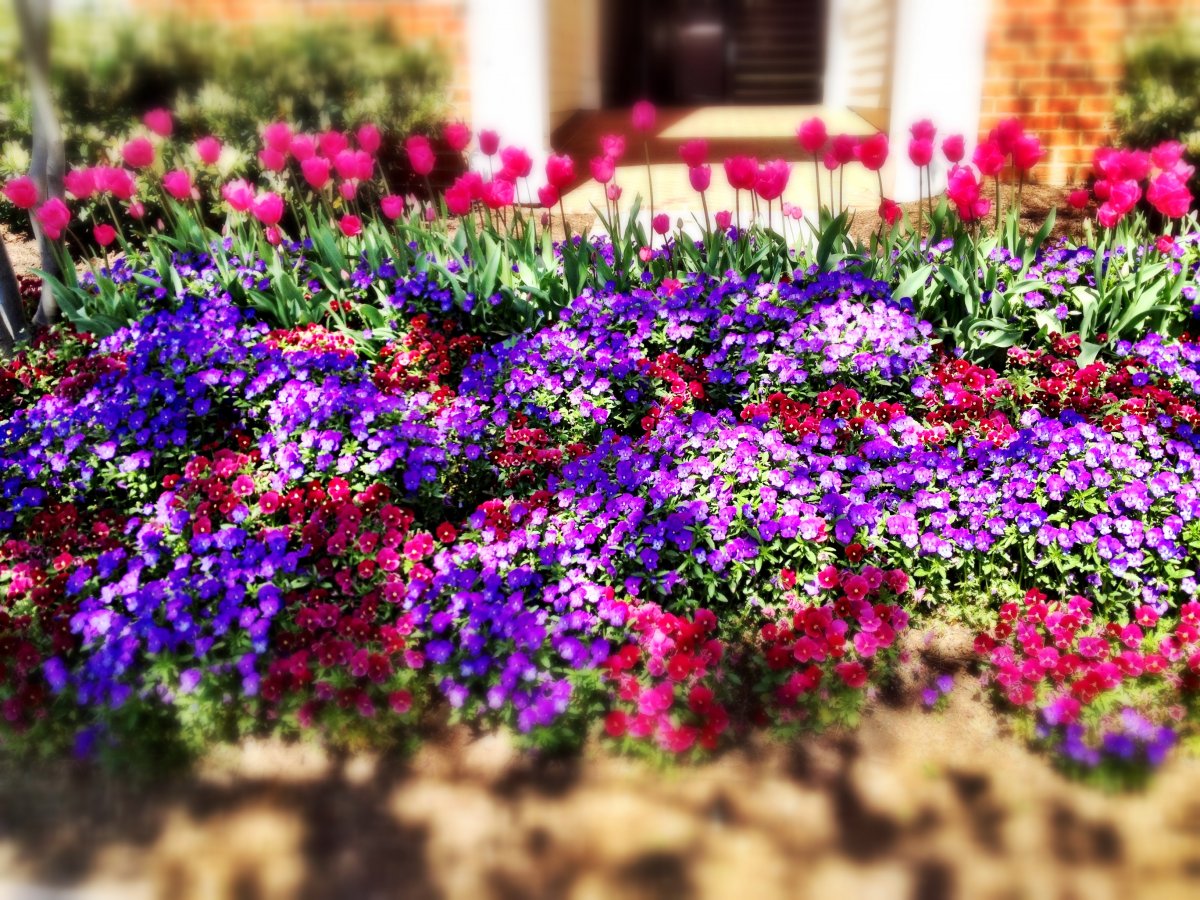
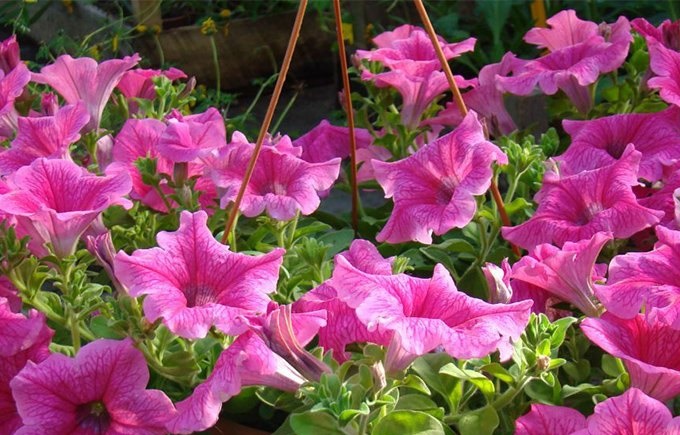
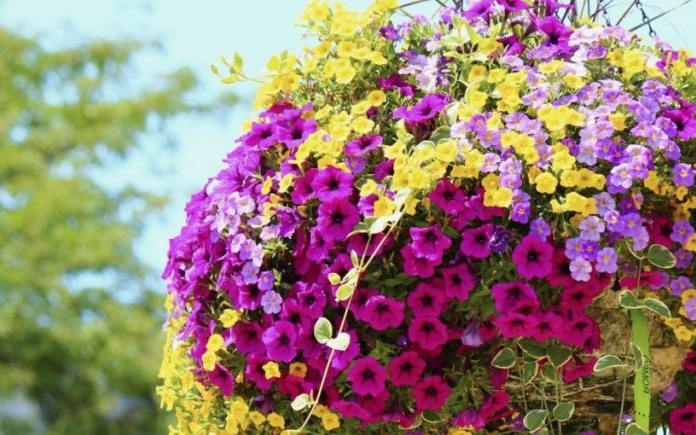
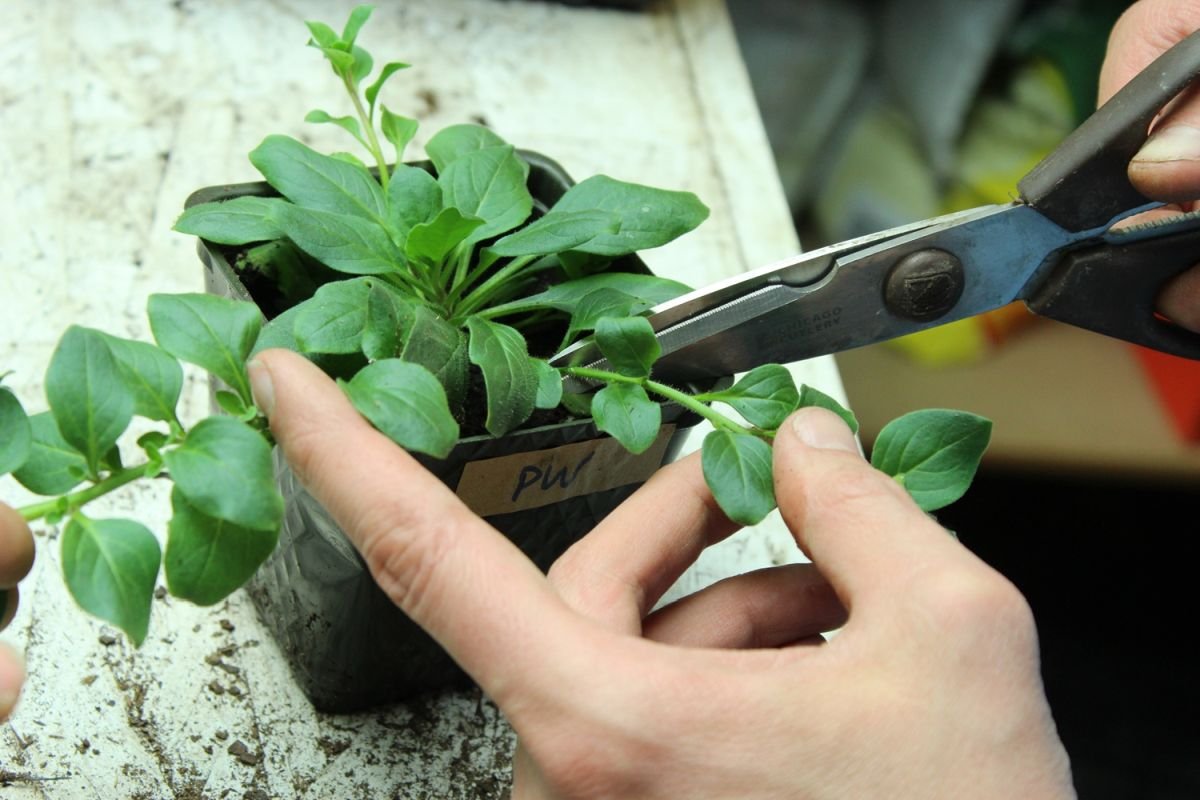 How to pinch a petunia to be magnificent
How to pinch a petunia to be magnificent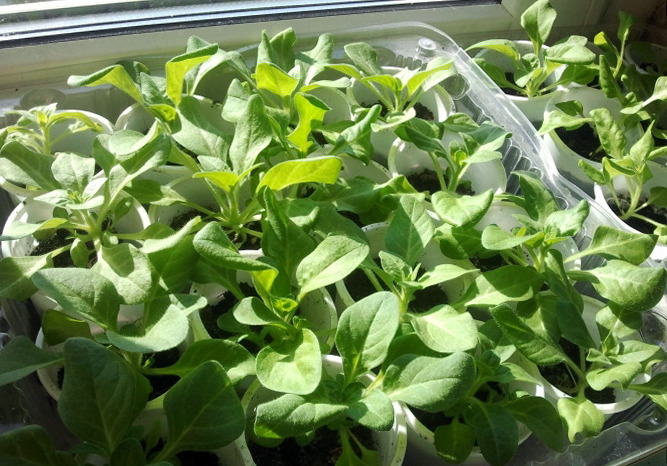 Fertilizing petunia seedlings for growth at home
Fertilizing petunia seedlings for growth at home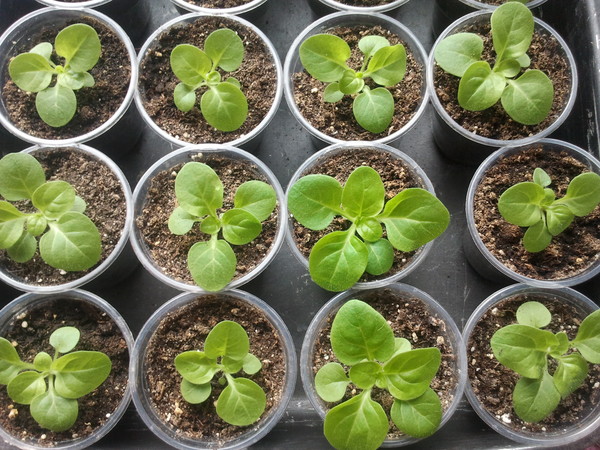 Sowing petunia seeds for seedlings - tricks and secrets
Sowing petunia seeds for seedlings - tricks and secrets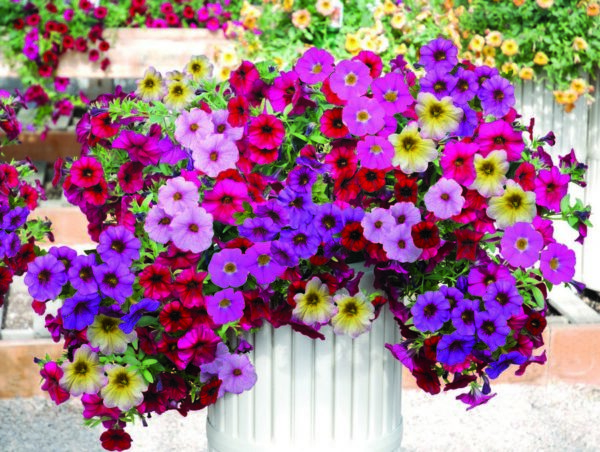 When to plant petunia for seedlings in 2018: planting calendar
When to plant petunia for seedlings in 2018: planting calendar